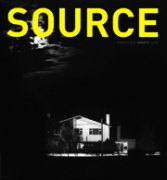At Ground Level
Andreas Gursky, New Work - White Cube, Mason's Yard 2007
Review by David Green
Issue 51 Summer 2007
View Contents ▸
If there is a predictability to Andreas Gursky's work these days it nonetheless continues to elicit no small measure of reverence. As they get even bigger the sheer size of the photographs alone demand our respect. Yet, perhaps more important is the awareness of the immense and complex infrastructure upon which these images depend: from the extensive logistics of pre-shoot planning to the expenditure of time and labour in studio production, Gursky's practice raises the level of ambition for photography to the sphere of art. Whilst most aspiring students of photography could manage a passable pastiche of a Tillman's installation, and a few might be able to master the technical and economic demands of large format photography à la Seawright or Southam, none would be able to emulate Gursky. With Gursky photography gets about the closest it ever has to rivalling its younger sibling: if one were to compare these images to cinema it would not be on aesthetic grounds but on the fact that they involve something of the social, technological and economic investment that is usual in the film industry. On purely commercial grounds it is the level of such investment that has demanded a reasonable return and why Gursky currently holds the record for highest price ever paid for a photograph.
If this seems a particularly lumpen observation, I should point out that it is borne from the frustration (or is it simply anger?) with press releases from blue-chip art galleries that peddle Gursky's work as insightful observation (or is it critique?) of our increasingly postmodern globalized world, the information age, the loss of the real in an era of simulation, etc, etc. On the other hand, who is better placed to speak of such things than those who trade in commodities that these days know no international political boundaries and that are - economically and communicatively - emblematic of the processes of globalization? There is, of course, a serious issue here. If there is no Archimedean point outside of all of this (and certainly not one that can be occupied by art dealers) where do we locate Gursky's work? Beelitz, 2007 - Andreas Gursky / VG Bild-Kunst, Courtesy: Monika Sprüth / Philomene Magers, Cologne Munich London
Beelitz, 2007 - Andreas Gursky / VG Bild-Kunst, Courtesy: Monika Sprüth / Philomene Magers, Cologne Munich London
This is a question that has been central to the various theoretical and critical discourses around Gursky's images. If the practice as a whole might be taken (and perhaps has to be taken) as symptomatic of the operations of capitalist production and distribution in the era of globalization, it also engages the conditions of its own making at the level of representation. It does so in the first, and most obvious way, in what it depicts; through the now familiar iconology of modern factories, shopping malls, corporate architecture, the spaces of mass spectacle, and so on. More ambiguously, it does so through aspects of style. Here, inevitably, we enter the realm of metaphor, where matters of camera angle, composition, image detail, highly saturated colour, pattern and surface are read as expressive of the conditions of the new psychological, social and political zeitgeist.
Above all else it is with the adoption of an elevated viewpoint, and the resulting flattening of pictorial space of a panoramic scene, that Gursky has discovered not simply the inimitable key to his signature style but the ostensible governing principle of the contemporary world order: Abstraction. The thinking is simple. If we now inhabit a world fathomless in terms of its complexity, and which has abandoned the prospect of any form of individual agency, then what better way to figure this than through the dehumanized God-like vantage point that flattens everything into a highly formalised two dimensional image?
This is tricky territory, and its not surprising that critical opinion on Gursky's work divides on the issue of what we are to make of this convergence of the aesthetic and the political. In the end, however, it is perhaps the adequacy of the politics that looks suspect. One of the most recent photographs on view at the White Cube was a high aerial view of an asparagus field near Potsdam in Germany, in which the agricultural workers are barely visible between the rows of black plastic sheeting protecting the crops. At the time of writing, these crops are rotting where they stand since the imposition of social security payments has led to a shortage of the low paid migrant workers from Eastern Europe upon whom the industry depends.
Taken from on high Gursky's photographs of the crowded floors of various international stock exchanges, the hi-tech factories of the West or the sweat shops of the Third World, make everything look remarkably similar, whereas we know that down there - at ground level - the life experience of individuals and of social groups remains very different.
Other articles by David Green:
Other articles mentioning Andreas Gursky:






